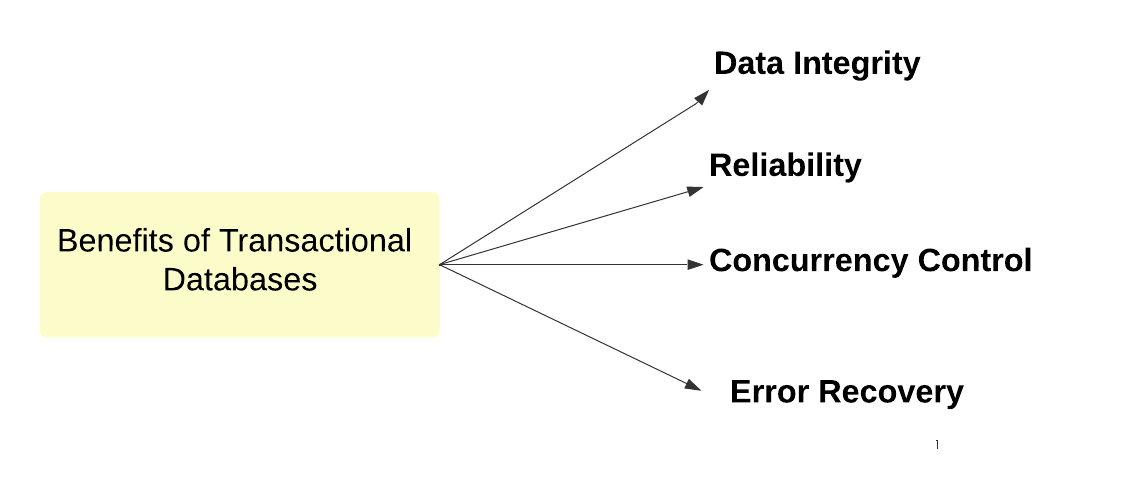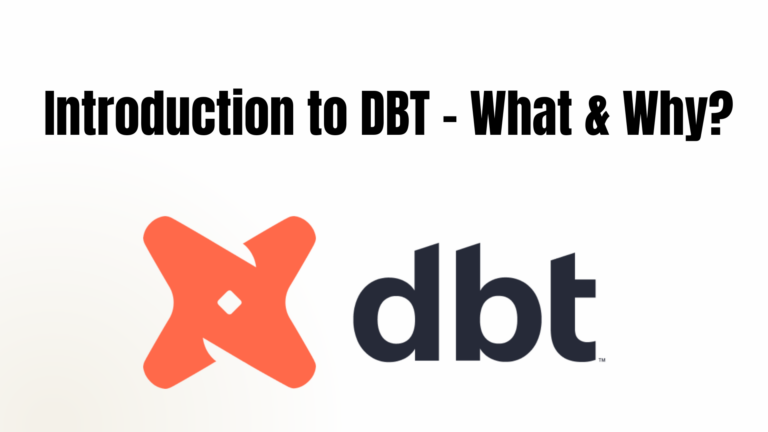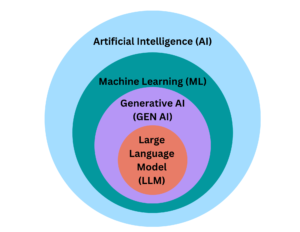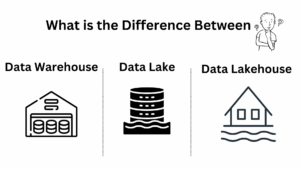Table of Contents
Transactional databases are designed to manage and facilitate transactions in a way that ensures data integrity and consistency. They are typically used in environments where numerous transactions occur, such as in financial services, retail, and other businesses that require robust data management systems. Key characteristics of transactional databases (ACID properties) include:
How Does a Transactional Database Work?
Imagine you are using an online banking system to transfer money from your account to a friend’s account. Here’s how a transactional database ensures this process is handled reliably and accurately:
Step-by-Step Process with Key Features
- Initiate the Transfer:
- Atomicity: You log in to your online banking app and start a transaction to transfer $500 to your friend’s account. The system begins tracking this transaction, ensuring that it will either be fully completed or not executed at all.
- Check and Deduct Balance:
- Isolation: The system checks your account to ensure sufficient funds. It then temporarily deducts $500 from your account. This operation is isolated, so other transactions cannot interfere or see this temporary state until it is finalized.
- Credit Friend’s Account:
- Consistency: The system credits $500 to your friend’s account. Consistency checks ensure that both the debit and credit operations adhere to the rules and constraints, maintaining the integrity of the database.
- Commit or Rollback:
- Atomicity: The system performs consistency checks. If all checks pass, the transaction is committed, making the changes permanent. If any step fails, the transaction is rolled back, reverting both accounts to their previous states, ensuring an all-or-nothing execution.
- Ensure Durability and Isolation:
- Durability: The committed transaction details are written to a persistent log to guarantee that the changes are permanent and can survive system failures.
- Isolation: Throughout the process, isolation mechanisms ensure that concurrent transactions do not interfere with each other, maintaining accurate and reliable transaction processing.
By incorporating these four key features—atomicity, consistency, isolation, and durability—the transactional database ensures your money transfer is processed reliably, accurately, and safely.
Types of Transactional Databases
Transactional databases are designed to handle and manage transactions reliably, ensuring data integrity and consistency. Depending on their specific use cases and architecture, they can be categorized into several types:
- Relational Databases (RDBMS)
- Description: These traditional databases use structured tables and SQL (Structured Query Language) to manage transactions. They are built on the relational model, where data is organized into tables that can be linked based on relationships.
- Features: Relational databases adhere to ACID (Atomicity, Consistency, Isolation, Durability) properties, ensuring strong consistency and data integrity during transaction processing.
- Examples: MySQL, PostgreSQL, SQL Server, and Oracle Database are well-known examples that provide robust support for transactional operations.
- Distributed Transactional Databases
- Description: These databases manage transactions across multiple databases or nodes in a distributed system. They are designed to handle the complexities of distributed environments, such as network communication and data consistency across various locations.
- Features: They ensure ACID properties across distributed nodes, often employing advanced protocols to maintain consistency and reliability.
- Examples: Amazon DynamoDB, Google Spanner, and CockroachDB are prominent examples that support distributed transaction management.
- NoSQL Databases with Transactional Support
- Description: NoSQL databases, typically known for their flexibility and scalability, offer varying levels of transactional support. These databases focus on accommodating unstructured or semi-structured data and may provide ACID compliance through specific features or extensions.
- Features: While not all NoSQL databases guarantee full ACID properties, some newer or advanced versions include transactional capabilities to support reliable data handling.
- Examples: MongoDB (with multi-document transactions) and Apache Cassandra (with limited transactional features) exemplify NoSQL databases offering some level of transactional support.
- In-Memory Databases
- Description: These databases store data in RAM to provide fast access and high performance. They often support transactional operations with a focus on low latency and rapid data processing.
- Features: In-memory databases typically offer ACID compliance for transactions, ensuring reliable data management even with their high-speed performance.
- Examples: Redis (with limited transactional features) and SAP HANA are notable in-memory databases designed for swift transactional handling.
Each type of transactional database is tailored to meet specific needs, from traditional relational systems offering robust transaction management to NoSQL and in-memory databases providing flexible and high-performance transaction handling. Understanding these types helps in selecting the right database for various applications, ensuring effective and reliable transaction processing.
Transactional Database Examples
Transactional databases are designed to handle real-time transactions with a focus on data integrity and consistency. Here’s how some popular databases fit into this category:
- MySQL: MySQL is a transactional database. It supports ACID properties when using its InnoDB storage engine, which is designed for handling transactions reliably.
- DynamoDB: Amazon DynamoDB can be used as a transactional database. It supports ACID transactions for handling multiple operations in a single, all-or-nothing transaction, although its approach to transactions is different from traditional RDBMS systems.
- NoSQL: NoSQL databases, in general, are not inherently transactional. They prioritize scalability and flexibility over strict ACID compliance. However, some NoSQL databases, like DynamoDB and newer versions of MongoDB, do offer transactional capabilities.
- SQLite: SQLite is a transactional database. It supports ACID properties and is used for applications requiring reliable transaction processing, often in local or embedded environments.
- SQL Server: Microsoft SQL Server is a transactional database. It fully supports ACID properties and is widely used for enterprise applications requiring robust transaction management.
- PostgreSQL: PostgreSQL is a transactional database. It adheres to ACID properties and is known for its advanced transaction and concurrency control features.
- MongoDB: MongoDB can be used for transactional applications. Starting with version 4.0, MongoDB supports multi-document ACID transactions, allowing it to handle transactions similarly to relational databases.
- MariaDB: MariaDB is a transactional database. It supports ACID properties through its InnoDB and Aria storage engines, making it suitable for transaction-heavy applications.
Common mistakes include assuming that Snowflake and Redis are transactional databases, but this is not correct.
- Snowflake: Snowflake is not a transactional database. It is a cloud-based data warehouse designed for analytical processing and large-scale data querying rather than real-time transaction processing.
- Redis: Redis is not typically classified as a transactional database. It is an in-memory data structure store known for high performance, but it does not fully support ACID properties or transactions in the traditional sense.
While many traditional relational databases like MySQL, PostgreSQL, SQL Server, and SQLite are well-suited for transactional applications, some NoSQL databases like DynamoDB and MongoDB have incorporated transactional features. However, systems like Redis and Snowflake are not designed primarily for transactional processing.
Benefits of Transactional Databases
Transactional databases are essential for managing real-time data and ensuring the accuracy and consistency of transactions. They are designed to handle daily operations efficiently while maintaining data integrity through rigorous ACID (Atomicity, Consistency, Isolation, Durability) principles. This makes them particularly valuable for applications requiring dependable transaction processing. Transactional databases offer several key advantages:

- Data Integrity: They ensure that all transactions are completed accurately and consistently, maintaining data integrity through ACID properties.
- Reliability: They handle real-time transactions effectively, providing reliable performance for everyday operations such as financial transactions and order processing.
- Concurrency Control: They manage multiple transactions simultaneously, ensuring that data remains accurate and consistent even with high user activity.
- Error Recovery: They include mechanisms for recovering data in case of system failures, ensuring that transactions are not lost and data remains intact.
These benefits make transactional databases essential for systems where accurate, reliable, and real-time transaction processing is critical.
Disadvantages and Limits of Transactional Databases
Transactional databases, while essential for many applications, come with certain disadvantages and limitations. Here are some of the key drawbacks:
- Performance and Scalability Issues: Transactional databases can experience performance overhead due to the need to maintain ACID properties, including locks and logging. This can impact scalability, as horizontal scaling is complex and often requires vertical scaling, which has its limits.
- Complexity in Distributed Systems: Managing transactions across distributed nodes adds complexity and can lead to increased latency and operational challenges.
- High Resource Consumption: These databases often require significant system resources for transaction management, indexing, and concurrency control, which can drive up operational costs.
- Limited Flexibility: Traditional transactional databases have fixed schemas, making schema changes complex and disruptive. They also struggle with handling unstructured data efficiently
- Risk of Deadlocks: In highly concurrent environments, transactions may cause deadlocks, leading to performance issues and requiring additional mechanisms for resolution.
While transactional databases are critical for ensuring data integrity and consistency in many applications, they can face challenges related to performance, scalability, complexity, and resource consumption.
Differences Between Transactional Databases and Analytical Databases
Transactional databases and analytical databases serve distinct purposes and are optimized for different types of data processing. Here’s a clear comparison highlighting their key differences:
Transactional Databases
Transactional databases are designed to handle real-time transactions and manage daily operational tasks with a focus on data integrity and consistency. They are optimized for processing individual transactions efficiently and ensuring that each transaction is executed correctly.
Key Features and Use Cases:
- Purpose: Tailored for applications requiring high transaction throughput and immediate data consistency, such as online retail systems, banking applications, and customer relationship management (CRM) systems.
- Data Processing: Emphasizes rapid read and write operations for transactions, processing them in real-time to maintain data integrity. They use a normalized schema to reduce redundancy and ensure consistency.
- Transaction Management: Ensures adherence to ACID properties (Atomicity, Consistency, Isolation, Durability) to maintain data accuracy during concurrent transactions. This guarantees that transactions are processed reliably even in high-load environments.
- Scalability: Typically scaled vertically (by adding resources to a single server) or through complex horizontal scaling strategies (distributing across multiple servers). The focus is on maintaining high availability and data consistency.
- Performance: Optimized for low latency and quick response times to support high transaction volumes and real-time operations.
Examples: MySQL, PostgreSQL, SQL Server, and Oracle Database are classic examples of transactional databases, providing robust support for real-time transactional integrity and efficiency.
Analytical Databases
Analytical databases are optimized for handling large-scale data analysis and complex querying. They are designed to efficiently process and aggregate extensive datasets, making them suitable for business intelligence and decision-making tasks.
Key Features and Use Cases:
- Purpose: Suited for applications requiring complex queries, data aggregation, and reporting, such as business intelligence tools, data warehousing, and analytics platforms.
- Data Processing: Focuses on executing complex queries and performing batch processing over large datasets. They often use denormalized or star/snowflake schemas to optimize query performance and simplify data analysis.
- Transaction Management: May not prioritize full ACID compliance, as the primary goal is efficient data retrieval and analysis rather than real-time transaction management. These systems are optimized for query performance and handling large volumes of data.
- Scalability: Typically scaled horizontally (by adding more servers) to manage increasing data volumes and processing demands. They are designed to handle large-scale data aggregation and complex analytical queries efficiently.
- Performance: Optimized for high performance in query execution and data processing, focusing on analyzing large datasets and generating insights quickly.
Examples: Snowflake, Google BigQuery, and Amazon Redshift are prominent examples of analytical databases, offering high performance for complex queries and large-scale data analysis.
Transactional databases excel in managing real-time transactions and ensuring data consistency, making them ideal for operational tasks. Analytical databases, on the other hand, are optimized for querying and processing large volumes of data, supporting in-depth analysis and reporting. Understanding these differences helps in selecting the appropriate database type based on the specific needs of your application.
What are non-transactional databases?
A non-transactional database is a type of database system that does not fully support the traditional transactional properties of ACID (Atomicity, Consistency, Isolation, Durability). These databases often prioritize other factors, such as performance, scalability, or flexibility, over strict transactional integrity. Here’s a breakdown of their characteristics:
Characteristics of Non-Transactional Databases
- Lack of Full ACID Compliance:
- Non-transactional databases may not guarantee that all aspects of a transaction are executed atomically or rolled back together in case of failure. They might not ensure consistency before and after transactions, provide strict isolation between concurrent transactions, or offer durability to protect committed data from system failures.
- Performance Focus:
- These databases are designed for high-performance and rapid read/write operations. They often excel in scenarios where speed is crucial, and where the overhead of maintaining ACID properties would hinder performance. This makes them ideal for applications such as caching systems and real-time analytics.
- Flexibility and Scalability:
- Non-transactional databases are often built to handle large volumes of data and can be easily scaled horizontally. This scalability is beneficial for big data applications and scenarios that require the processing of unstructured or semi-structured data, where traditional transactional databases might struggle.
- Types of Non-Transactional Databases:
- NoSQL Databases: Many NoSQL databases, including key-value stores (e.g., Redis), document stores (e.g., MongoDB – the old versions- ), and column-family stores (e.g., Apache Cassandra), are designed without full ACID compliance. They offer various features that enhance performance and scalability over strict transactional guarantees.
- Data Warehouses: Systems like Snowflake are optimized for large-scale data analysis and querying rather than real-time transaction management. They focus on providing high performance for complex queries and data processing.
Non-transactional databases are tailored for environments where performance and scalability are prioritized over strict transactional integrity. They are well-suited for applications requiring high throughput, flexibility in handling diverse data types, and the ability to scale out efficiently. Understanding these databases helps in selecting the right system based on the specific needs of the application, balancing performance with the level of transactional consistency required.
Conclusion
Transactional databases play a key role in managing everyday operations and ensuring data accuracy. They are designed to handle transactions in real-time while keeping data consistent and reliable, thanks to their ACID (Atomicity, Consistency, Isolation, Durability) properties. This makes them perfect for systems like banking, online shopping, and customer management.
While they are great for ensuring dependable transaction processing, transactional databases can face issues with performance, scalability, and complexity, especially in large or distributed systems. Knowing how these databases work helps you choose the right one to meet your needs, balancing reliable data handling with efficient operation.
Read also
What is the Difference Between a Data Lake and a Delta Lake?
ETL vs. ELT vs. ELTP: Understanding the Evolution of Data Integration
Apache Airflow Tutorial: Architecture, Concepts, and How to Run Airflow Locally With Docker




